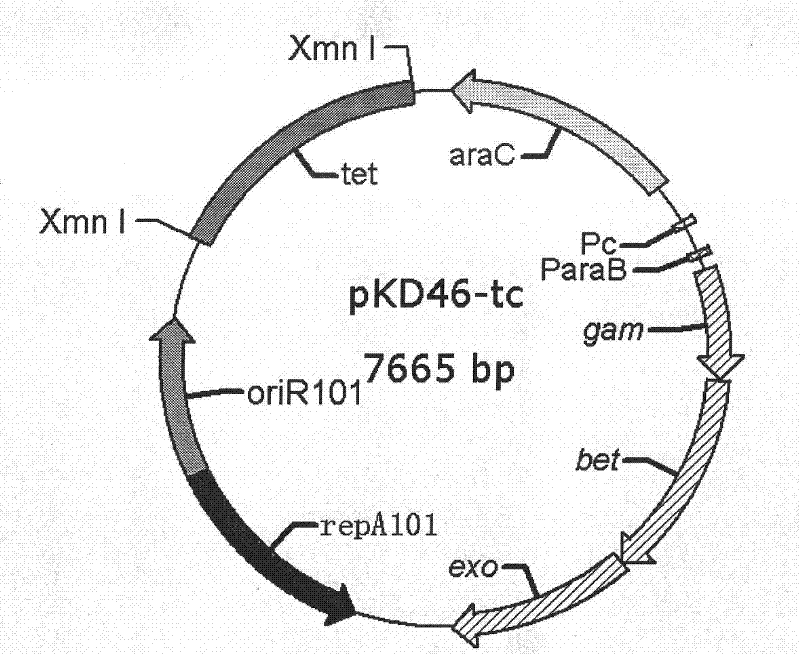Method for producing 1, 3 propylene glycol safely and highly efficiently
A propylene glycol, high-efficiency technology, applied in the field of bioengineering, to achieve the effect of pro-secretion
- Summary
- Abstract
- Description
- Claims
- Application Information
AI Technical Summary
Problems solved by technology
Method used
Image
Examples
Embodiment 1
[0029] Embodiment 1, construct the Red recombinant plasmid system pKD46-Tc and pCP20-Tc applicable to Klebsiella
[0030] Through sequence search, it is found that there is an Xmn I restriction enzyme site on the Amp resistance gene of these two plasmids, and there is only one of this site in the whole plasmid, inserting other resistance genes at this position can make these two plasmids have New resistance marker, while removing the Amp resistance marker.
[0031]Using the pBR322 plasmid as a template, design primers F-tet (5'-GGAAAACGTTCCTCATGTTTGACAGCTFATCATCG-3') and R-tet (5'-GGAACATTTTCGGAGTGGTGAATCCGTTAGCG-3') for the tetracycline resistance gene, with Xmn I restriction sites on both ends , amplify the tet gene by PCR, recover the tet fragment from the gel, transform it into DH5α competent cells after being connected to the T carrier, smear LB plates (tetracycline hydrochloride 20 μg / ml), and culture overnight at 37°C for 12-16 hours; single clones are picked the next d...
Embodiment 2
[0034] Embodiment 2, knockout the capsular gene wzi of Klebsiella
[0035] 1. Two-step PCR method to amplify the fragment Δwzi::FK
[0036] Using the pKD4 plasmid as a template, primers F-FRT and R-FRT were designed to amplify the kan resistance gene fragment FK (about 1500bp) containing FRT sites at both ends. Determine that the homology arm is 250bp, design the primers Fup-wzi and Rup-wzi::FRT at both ends of the upstream 250bp sequence of the wzi fragment, and add the partial sequence of F-FRT to the 5' end of the reverse primer, and the downstream 250bp sequence of the wzi fragment A partial sequence of R-FRT was added to the 5' end of the forward primer Fdown-FRT::wzi and Rdown-wzi forward primer, and the genome of K.pneumoniae ATCC49790 was used as a template to amplify. The three fragments up-wzi, down-wzi, and FK amplified by PCR were mixed according to the substance ratio of 1:1:1 as a template, and Fup-wzi and Rdown-wzi were used as primers to amplify the fragment Δ...
Embodiment 3
[0041] Embodiment 3, the characteristic of knocking out capsular gene wzi Klebsiella
[0042] 1. Capsule staining experiment
[0043] Dip the Klebsiella strains cultured overnight and the Klebsiella bacteria with capsule knockout respectively, and spot on two glass slides, after natural drying, stain with 1% crystal violet aqueous solution for 2min, wash with 20% CuSO4, and then wash with absorbent paper Wipe off the residual liquid and observe the phenomenon under the oil immersion lens. The results of microscopic examination of the original bacterial liquid showed that the bacterial cells were stained dark purple, and the capsule around the bacterial cells was lavender. The results of microscopic examination of the capsule-knockout bacterial fluid showed that there were only dark purple bacterial cells without surrounding lavender capsules.
[0044] 2. Transformation efficiency experiment
[0045] Use 10% glycerol to prepare competent cells of original and capsulated Kleb...
PUM
 Login to View More
Login to View More Abstract
Description
Claims
Application Information
 Login to View More
Login to View More - R&D
- Intellectual Property
- Life Sciences
- Materials
- Tech Scout
- Unparalleled Data Quality
- Higher Quality Content
- 60% Fewer Hallucinations
Browse by: Latest US Patents, China's latest patents, Technical Efficacy Thesaurus, Application Domain, Technology Topic, Popular Technical Reports.
© 2025 PatSnap. All rights reserved.Legal|Privacy policy|Modern Slavery Act Transparency Statement|Sitemap|About US| Contact US: help@patsnap.com



